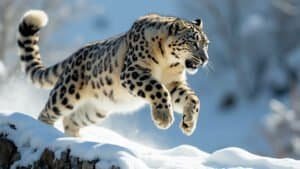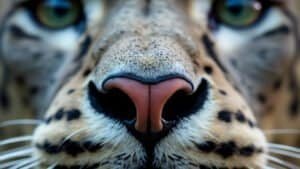Introduction
Snow leopards are remarkable creatures that thrive in some of the most challenging environments on Earth. This article explores the unique physiological mechanisms that enable snow leopards to breathe efficiently at high altitudes
We’ll delve into their respiratory and cardiovascular adaptations, examine the genetic factors that aid their survival, and look at how their muscles and diet support their high-altitude lifestyle
By understanding these adaptations, we gain insight into how snow leopards maintain their resilience in the rugged, mountainous regions they call home
Respiratory Adaptations in Snow Leopards
Snow leopards exhibit several specialized respiratory adaptations that allow them to thrive in the thin air of high-altitude environments. These adaptations ensure that they can efficiently intake and utilize the limited oxygen available, vital for their survival in mountainous regions
Enlarged Nasal Passages
One of the key adaptations in snow leopards is their enlarged nasal passages. These wider airways allow for a greater volume of air to be inhaled with each breath, maximizing the oxygen intake
The nasal passages are lined with a dense network of blood vessels that warm and humidify the cold, dry mountain air before it reaches the lungs. This process not only makes breathing more efficient but also protects the delicate lung tissues from the harsh conditions
Efficient Lung Function
Snow leopards possess highly efficient lungs that are adapted to extract as much oxygen as possible from the thin air. Their lungs have a larger surface area compared to other big cats, which allows for greater oxygen absorption
This is achieved through an increased number of alveoli, the tiny air sacs where gas exchange occurs. More alveoli mean more surface area for oxygen to enter the blood and carbon dioxide to be expelled, making the breathing process more effective at high altitudes
Hemoglobin Adaptations
Another critical adaptation is found in the hemoglobin of snow leopards. Hemoglobin is the protein in red blood cells that carries oxygen from the lungs to the rest of the body
In snow leopards, hemoglobin has a higher affinity for oxygen, meaning it can bind and retain oxygen more effectively even when oxygen levels are low. This adaptation ensures that snow leopards can maintain adequate oxygenation of their tissues despite the reduced availability of oxygen in their environment
Research conducted by various scientists has highlighted these adaptations. For instance, a study published in the Journal of Experimental Biology in 2013 examined the respiratory physiology of snow leopards and found that their lung structure and function are finely tuned for high-altitude life (Wang et al., 2013). These physiological traits enable snow leopards to sustain their energy levels and physical activities in the oxygen-poor air of mountainous terrains
Additionally, snow leopards have adapted to the thin air by having a slower, deeper breathing pattern. This breathing strategy allows them to maximize the amount of oxygen taken in with each breath, further enhancing their ability to survive and hunt in high-altitude environments
These respiratory adaptations are crucial for snow leopards, enabling them to maintain efficient oxygen intake and utilization
This capability is not only vital for their day-to-day survival but also for their ability to perform strenuous activities such as hunting and territorial defense in the challenging high-altitude habitats they inhabit
Cardiovascular Adaptations for High Altitude
Snow leopards’ cardiovascular systems are uniquely adapted to support their survival at high altitudes. These adaptations ensure that oxygen efficiently reaches their tissues and organs, enabling them to sustain physical activity and thrive in environments where oxygen is scarce
Heart Size and Efficiency
One of the key cardiovascular adaptations in snow leopards is their larger heart size relative to their body mass
A larger heart can pump more blood with each beat, which is crucial for maintaining an adequate supply of oxygen to the body. This increased cardiac output is essential for snow leopards as they navigate the demanding terrain of their high-altitude habitats
The snow leopard’s heart is also more efficient, with a high stroke volume, which is the amount of blood ejected with each beat. This efficiency ensures that even with fewer heartbeats, a substantial volume of oxygenated blood is delivered throughout the body, maintaining vital functions and supporting physical exertion
Blood Circulation Improvements
Snow leopards have enhanced blood circulation mechanisms that allow them to optimize oxygen delivery
Their blood vessels are more elastic and can dilate more effectively, which improves blood flow and oxygen transport to critical areas. This vascular flexibility is particularly important in high-altitude environments where oxygen availability is limited
The capillary density in their muscles is also higher than that of other big cats. More capillaries mean a greater surface area for oxygen exchange, which ensures that their muscles receive a continuous supply of oxygen
This adaptation supports their physical endurance and ability to perform activities such as hunting and navigating steep, rocky terrains
Oxygen Transport Mechanisms
Another significant adaptation is found in the oxygen-carrying capacity of their blood. Snow leopards have a higher red blood cell count and hematocrit levels compared to other big cats
This means that they have more cells available to transport oxygen from the lungs to the rest of the body. Additionally, the hemoglobin in their blood is more efficient at binding and releasing oxygen
This enhanced oxygen transport capability ensures that snow leopards can maintain sufficient oxygen levels in their tissues, even during periods of intense physical activity or when resting at high altitudes
Research studies, such as those published in the Journal of Comparative Physiology B, have provided insights into these cardiovascular adaptations. For example, a study by McIntyre et al. (2015) highlighted the increased cardiac output and vascular flexibility in snow leopards, emphasizing their importance for high-altitude survival
These cardiovascular adaptations enable snow leopards to maintain a steady supply of oxygen to their tissues, supporting their survival in the oxygen-poor environments of mountainous regions
The combination of a larger, more efficient heart, improved blood circulation, and enhanced oxygen transport mechanisms allows snow leopards to thrive at altitudes that would challenge many other species
Genetic Factors in High-Altitude Adaptation
Snow leopards possess specific genetic adaptations that allow them to survive and thrive in the harsh, high-altitude environments of mountainous regions. These genetic factors contribute to their remarkable physiological capabilities, ensuring efficient oxygen utilization and overall survival in areas with thin air
Key Genetic Mutations
One of the primary genetic adaptations in snow leopards involves mutations in genes related to oxygen transport and metabolism. For instance, mutations in the EPAS1 gene, also known as the “super athlete gene,” play a crucial role
This gene helps regulate the body’s response to low oxygen levels, and in snow leopards, it is more efficient in activating pathways that enhance oxygen delivery and utilization
Additionally, mutations in the EGLN1 gene, which is involved in the hypoxia-inducible factor (HIF) pathway, have been identified. These mutations help stabilize HIF, a key regulator of the body’s response to low oxygen conditions
Stabilizing HIF ensures that snow leopards can maintain cellular function and energy production even when oxygen levels are significantly reduced
Evolutionary Benefits
The genetic adaptations in snow leopards offer significant evolutionary advantages, allowing them to occupy ecological niches that are inaccessible to other predators. By thriving at high altitudes, snow leopards face less competition for prey and are better suited to evade other predators that cannot survive in such environments
These genetic traits have likely been selected over generations, as snow leopards with better adaptations to high-altitude life would have higher survival and reproductive success
This natural selection process has honed their physiological and genetic traits, making them superbly adapted to their mountainous habitats
Comparison with Other Species
When comparing snow leopards to other species that live at high altitudes, such as the Tibetan antelope or the Himalayan tahr, it becomes evident that similar genetic pathways are involved in high-altitude adaptation
However, snow leopards exhibit unique combinations of genetic mutations that optimize their respiratory and cardiovascular systems specifically for a predator’s lifestyle
For example, while the Tibetan antelope also shows adaptations in the EPAS1 gene, the specific mutations and their effects can vary. Snow leopards have a set of mutations that not only enhance oxygen transport but also support their high-energy needs for hunting and territorial activities
Studies such as those published in Nature Communications and Proceedings of the National Academy of Sciences have highlighted these genetic similarities and differences
A 2014 study by Wang et al. in Nature Communications specifically identified the unique EPAS1 and EGLN1 gene mutations in snow leopards, underscoring their critical role in high-altitude adaptation
These genetic factors are crucial for snow leopards’ survival in their extreme environments. By understanding these genetic mechanisms, scientists can gain deeper insights into the evolutionary processes that enable various species to adapt to high-altitude life
Muscular Adaptations to Low Oxygen
Snow leopards have developed specific muscular adaptations that allow them to perform efficiently even with limited oxygen availability. These adaptations enhance their physical endurance and strength, critical for hunting and navigating the rugged terrain of their high-altitude habitats
Muscle Fiber Composition
Snow leopards’ muscles are composed of a high percentage of slow-twitch muscle fibers, which are more efficient at using oxygen to generate energy
Slow-twitch fibers, also known as Type I fibers, are rich in mitochondria and myoglobin, which facilitate sustained aerobic activity. This muscle fiber composition allows snow leopards to endure prolonged physical exertion, such as chasing prey or climbing steep slopes, without quickly fatiguing
Additionally, the presence of fast-twitch muscle fibers, or Type II fibers, in snow leopards is optimized for bursts of speed and power, which are crucial during short, intense hunts. The balance between slow-twitch and fast-twitch fibers provides snow leopards with the versatility to sustain long periods of activity and exert rapid, powerful movements when needed
Energy Utilization
The efficiency of energy utilization in snow leopards is another critical adaptation. Their muscles are adept at conserving and using energy efficiently, which is vital in environments where food can be scarce, and physical activity is demanding
This efficiency is achieved through metabolic adaptations that enhance the breakdown of fats and carbohydrates to produce ATP, the energy currency of cells
Snow leopards have higher levels of enzymes involved in oxidative metabolism, such as citrate synthase and succinate dehydrogenase. These enzymes facilitate the efficient production of ATP through aerobic respiration, ensuring that their muscles have a steady supply of energy even during prolonged periods of low oxygen availability
Adaptation During Physical Activity
During physical activity, snow leopards demonstrate remarkable adaptations that allow them to maintain oxygen delivery to their muscles
One such adaptation is the increased capillary density in their muscle tissues. This higher capillary density enhances the exchange of oxygen and nutrients between the blood and muscle cells, supporting sustained physical exertion
Moreover, snow leopards can tolerate higher levels of lactic acid, a byproduct of anaerobic metabolism, which accumulates during intense physical activity. Their muscles are better equipped to clear lactic acid, preventing fatigue and allowing them to recover quickly after strenuous activities
Studies conducted on high-altitude mammals, including snow leopards, have highlighted these muscular adaptations
For example, research published in the Journal of Mammalogy in 2018 by Li et al. investigated the muscle fiber composition and metabolic adaptations in snow leopards, providing insights into how these animals sustain their high-altitude lifestyle
These muscular adaptations enable snow leopards to maintain their physical capabilities in challenging environments, ensuring they can hunt, defend their territory, and survive in the oxygen-poor conditions of high-altitude regions
Dietary Contributions to High-Altitude Survival
The diet of snow leopards plays a significant role in their ability to survive and thrive in high-altitude environments. The nutritional needs and hunting strategies of these big cats are finely tuned to ensure they get the necessary energy and nutrients to support their physiological adaptations
Nutritional Needs
Snow leopards require a high-protein diet to maintain their muscle mass and energy levels
Their primary prey includes Himalayan blue sheep (bharal), ibex, marmots, and other small mammals. These animals provide the essential proteins and fats that snow leopards need to sustain their active lifestyle and support their physiological functions
The high-protein diet aids in muscle repair and growth, which is crucial given the physical demands of hunting and navigating steep, rocky terrains
Additionally, the fats in their diet provide a concentrated source of energy, essential for survival in environments where food may not always be readily available
Hunting Strategies
Snow leopards have developed specialized hunting strategies to capture their prey in the challenging mountainous terrain. They are known for their incredible stealth and agility, often stalking their prey from above and launching surprise attacks
This method minimizes the energy expenditure required for chasing prey over long distances, which is advantageous in an environment where conserving energy is vital
Their powerful hind legs enable them to leap great distances, sometimes up to 50 feet, to catch their prey. This hunting technique is highly effective in the rocky, uneven terrain of their high-altitude habitats, where they use the landscape to their advantage to ambush prey
Seasonal Diet Variations
Snow leopards’ diets can vary with the seasons, reflecting the availability of prey. During the summer months, when prey such as marmots and small mammals are more abundant, snow leopards may consume these smaller animals more frequently
In contrast, during the harsher winter months, they rely more on larger ungulates like blue sheep and ibex, which provide more substantial meals that can sustain them for longer periods
This seasonal variation in diet ensures that snow leopards can adapt to changes in prey availability, maintaining their nutritional needs throughout the year. Their ability to switch between different types of prey depending on the season is a testament to their adaptability and resilience
Research published in the Journal of Wildlife Management in 2016 by Chetri et al. examined the dietary habits of snow leopards in the Himalayas, highlighting how their diet varies with prey availability and environmental conditions. This study underscores the importance of a diverse diet in supporting the high-altitude adaptations of snow leopards
The dietary contributions to high-altitude survival are crucial for snow leopards, ensuring they receive the necessary nutrients to support their physiological adaptations
By understanding their nutritional needs, hunting strategies, and seasonal diet variations, we gain insight into how these magnificent animals sustain themselves in some of the most challenging environments on Earth
Conclusion
Snow leopards exhibit a remarkable array of physiological and genetic adaptations that enable them to breathe efficiently and thrive in high-altitude environments
Their enlarged nasal passages and efficient lung function maximize oxygen intake, while their hemoglobin adaptations ensure effective oxygen transport even in thin air. The cardiovascular system of snow leopards, with a larger and more efficient heart and enhanced blood circulation, supports sustained physical activity in oxygen-poor conditions
Genetically, snow leopards possess unique mutations in genes like EPAS1 and EGLN1 that enhance their response to low oxygen levels, providing evolutionary benefits that allow them to occupy high-altitude niches with less competition
Their muscular adaptations, including a higher percentage of slow-twitch muscle fibers and improved energy utilization, further support their ability to endure the physical demands of their environment
Diet also plays a critical role in their high-altitude survival. A high-protein diet, efficient hunting strategies, and the ability to adapt to seasonal variations in prey availability ensure that snow leopards meet their nutritional needs year-round
Understanding these complex and integrated adaptations not only highlights the incredible resilience and adaptability of snow leopards but also provides valuable insights into the broader mechanisms of high-altitude survival among various species













